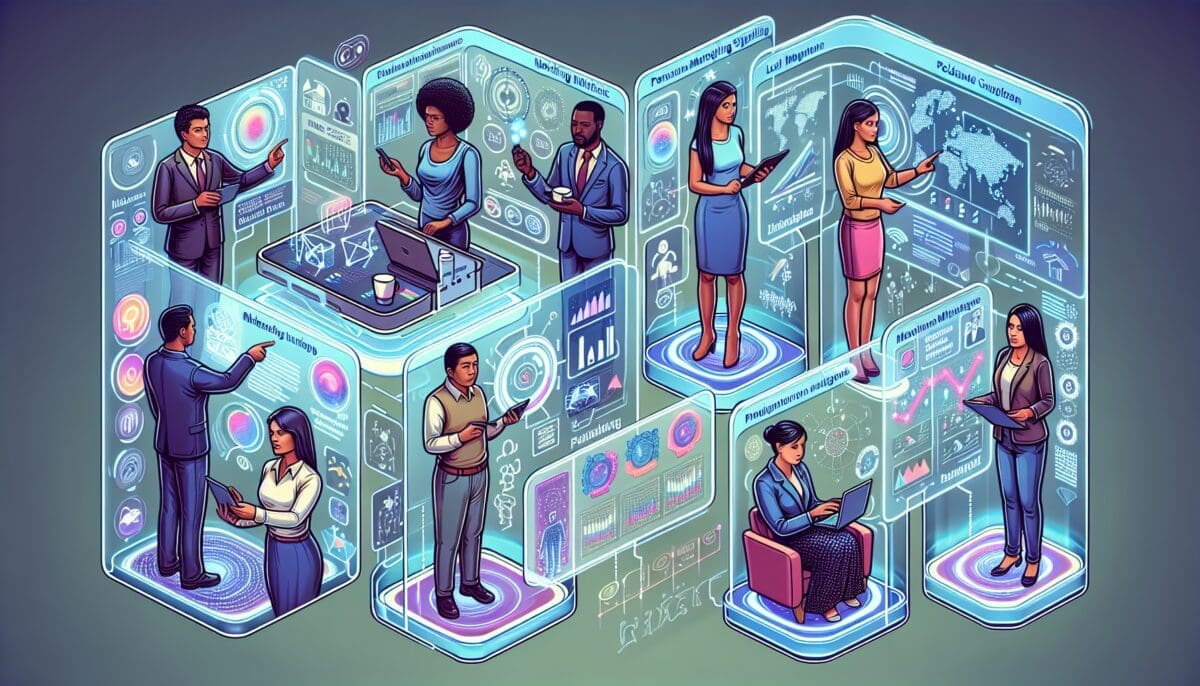Can small businesses scale personalized marketing?
The answer lies in the convergence of no-code platforms and generative AI. These technologies are revolutionizing how small and medium enterprises (SMEs) approach marketing. Imagine creating tailored campaigns without needing a tech team or a hefty budget. That’s the promise of no-code and generative AI.
No-code platforms empower businesses to build and deploy applications quickly. They eliminate the need for extensive coding knowledge, making technology accessible to everyone. Generative AI, on the other hand, uses machine learning to create personalized content at scale. Together, they offer a powerful toolkit for SMEs looking to enhance customer engagement.
Consider a local bakery that uses these tools to send personalized offers to its customers. By analyzing customer preferences and behavior, the bakery can craft messages that resonate on an individual level. This approach not only boosts engagement but also drives sales.
Ready to take your marketing to the next level?
Book a meeting to learn how you can implement these solutions in your business.
In this article, we’ll explore how no-code and generative AI can transform your marketing efforts. From understanding the basics to real-life success stories, we’ll cover it all. You’ll also discover data-driven insights and cost-effective strategies to maximize your ROI.
Stay tuned to uncover the future trends shaping personalized marketing for SMEs.
No-Code Platforms: A Revolution for Small Businesses

The digital age has democratized technology, allowing even the smallest enterprises to harness powerful tools previously reserved for large corporations. No-code platforms are at the heart of this revolution. They empower non-technical business owners to create robust applications without writing a single line of code. This shift is not just a trend but a game-changing movement in how small businesses operate and compete.
What is a No-Code Platform?
At its core, a no-code platform is a visual software development environment. It allows users to drag and drop application components, connect them, and create a functional application. This process is facilitated by user-friendly graphical user interfaces (GUIs). According to Hashstudioz, no-code platforms enable business owners, analysts, and even office managers to build and test applications with minimal knowledge of traditional programming languages.
“No-code platforms allow non-software professionals to design and test applications with very little knowledge of traditional programming languages.”
Hashstudioz
Benefits of No-Code Platforms for Small Businesses
No-code platforms offer several compelling advantages to small businesses:
- Speed and Efficiency: Building applications using no-code tools is significantly faster compared to traditional methods. This efficiency allows businesses to respond quickly to market changes and customer needs.
- Cost Savings: Hiring software developers can be prohibitively expensive for small businesses. No-code platforms eliminate this cost, enabling even those with limited budgets to develop sophisticated applications (CIOL).
- Empowerment of Non-Technical Staff: These platforms enable more team members to become “citizen developers,” increasing productivity and innovation within the organization.
Real-World Examples of No-Code Success
Many small businesses have already reaped the benefits of no-code platforms. For instance, a case study involving BigCommerce highlighted how integrating Bolt Checkout with no-code technology allowed merchants to set up seamless payment systems within minutes (Emeritus). This integration not only improved the user experience but also significantly boosted sales and customer satisfaction.
Overcoming Challenges in Adopting No-Code Solutions
While the benefits are clear, adopting no-code solutions isn’t without its challenges. Small businesses may face issues such as:
- Learning Curve: Despite their user-friendly interfaces, no-code platforms still require some learning and adjustment.
- Customization Limits: There may be limitations in customizing applications to meet very specific needs, which can be a drawback for some businesses.
- Integration with Existing Systems: Ensuring that new no-code applications seamlessly integrate with existing systems can be complex.
Practical Tips for Implementing No-Code Platforms
To maximize the benefits of no-code platforms, small businesses should consider the following strategies:
- Start Small: Begin with simple applications to get comfortable with the platform.
- Leverage Training Resources: Many no-code platforms offer extensive tutorials and community support.
- Iterate and Test: Use the platform’s testing capabilities to refine applications before full deployment.
In essence, no-code platforms represent a significant opportunity for small businesses to innovate and compete more effectively. By reducing costs, speeding up development, and empowering non-technical staff, these tools are democratizing the digital transformation process.
Leveraging Generative AI for Personalized Marketing Campaigns

Imagine being able to deliver content that feels tailor-made for each of your customers, increasing engagement and driving sales like never before. This is no longer a distant dream, but a reality made possible by generative AI. Small and medium-sized enterprises (SMEs) can now harness the power of AI to create highly personalized marketing campaigns that resonate deeply with their target audience.
Creating Tailored Content with Generative AI
Generative AI platforms, such as Einstein GPT, utilize vast datasets to produce personalized content across various customer relationship management (CRM) interactions. These platforms can integrate both public and private AI models to generate content that is uniquely tailored to individual customer preferences. By analyzing customer data, AI can craft personalized emails, social media posts, and advertisements that speak directly to each user’s interests and behaviors.
“Einstein GPT is a game-changer for businesses that want to improve their customer experience and boost sales.”
TIS (tisdigitech.com)
Enhancing Customer Engagement through AI-Powered Insights
AI can analyze vast amounts of customer data to uncover patterns and preferences that human marketers might miss. For instance, AI-powered analytics can help marketers understand the best times to send messages, the types of content that perform well, and the specific needs of different customer segments. This data-driven approach ensures that marketing messages are not only personalized but also delivered at the optimal time for maximum impact.
Real-World Examples of AI in Action
Small businesses across various industries are already reaping the benefits of AI-powered marketing. The internet is filled with examples. Here are a couple to help you get started:
- 101 real-world gen AI use cases from the world’s leading organizations | Google Cloud Blog
- 12 Mind-Blowing Use Cases for GPT-4
Practical Tips for Implementing AI in Marketing
For SMEs looking to implement AI in their marketing strategies, here are some actionable tips:
- Start Small: Begin with a specific area, like email marketing or social media, to test and refine your AI tools.
- Leverage Existing Platforms: Utilize established AI platforms that offer robust support and integration capabilities, such as Salesforce’s Einstein GPT.
- Monitor and Adjust: Continuously analyze the performance of your AI-driven campaigns and make necessary adjustments based on the insights gained.
By following these steps, small businesses can effectively integrate AI into their marketing efforts, driving greater personalization and engagement.
In summary, leveraging generative AI for personalized marketing campaigns allows SMEs to create highly targeted content that resonates with their audience, leading to improved engagement and sales. As you consider implementing these strategies, stay tuned for the next section, where we will explore overcoming the challenges of adopting no-code and generative AI solutions.
Case Studies: Success Stories of Businesses Using No-Code and Gen AI

Small businesses often face the challenge of limited resources and technical expertise. However, no-code platforms and generative AI are leveling the playing field, enabling these businesses to achieve remarkable success. Here are some inspiring examples that showcase the transformative power of these technologies.
Wix: Simplifying Web Development with AI
Wix.com Ltd. is an Israeli software company, publicly listed in the US, that provides cloud-based web development services. It offers tools for creating HTML5 websites and mobile sites using online drag-and-drop editing. Today, wix.com is a popular name in web development. They have a large number of templates to help you get started and today are augmented by AI features.
The AI will then design a website, including the initial copy, images and core pages needed to support your business. This method can shave off weeks—if not months—from the typical development process and present a fully functional website in minutes.
How long does it take to build a website? Here’s what to expect (wix.com)
FlutterFlow: Accelerating App Development
FlutterFlow has helped numerous startups and small businesses build mobile apps without writing a single line of code. This platform’s no-code capabilities streamline app development, reduce costs, and accelerate time-to-market. Their showcase page has multiple examples. A couple of them that caught my attention:
- Atlas – Rewards Credit Card (atlasfin.com) – YC founders switched to FlutterFlow & launched a rewards credit card with 5x higher approval rates than traditional credit cards
- Giftit – Gift without guessing (producthunt.com) – launched an AI chat tool in 3 months, integrated seamlessly with iMessage & WhatsApp
Gen AI: Enhancing Customer Service
No-code has helped a number of organisations leverage Generative AI for customer services. Some examples:
- Salesforce’s Service GPT combines its understanding of internal databses, CRM, customer data, with cusomer intenet to generate high quality responses to customer queries. Agents can then evaluate these answers and respond quickly and accurately to customers.
- Zendesk leverages GenAi to improve the quality of agent responses.
Your customers will know when they receive a run-of-the-mill reply, which may negatively affect their CX. People often associate automation with canned responses, but support agents can leverage the generative AI tools to enhance the quality of their replies and customer-facing ticket comments without spending too much time writing a custom reply for every customer.
Agents can do this by asking the software to:
ChatGPT for customer service: A complete guide (zendesk.com)
- Expand replies by adding conversational context and creating a customer-ready response. For example, if an agent wants to say “One sec,” AI can expand the reply to say “Please give me a moment as I look for a solution.”
- Change the tone to be more friendly or formal, depending on the customer.
Varyence: Leveraging AI for Predictive Analytics
Varyence uses AI-driven predictive analytics to help businesses automate customer service and improve customer satisfaction. For example, a small e-commerce store implemented Varyence’s AI solutions to predict customer preferences and offer personalized product recommendations. This led to a 15% increase in sales and a 25% reduction in churn rates. The AI algorithms analyzed customer service interactions, purchase history, and demographic data to provide actionable insights.
Gen Z Leaders: Innovating with Generative AI
Gen Z entrepreneurs are leveraging generative AI tools like ChatGPT and Dall-E to revolutionize their business processes. For instance, a Gen Z founder of an e-commerce platform used ChatGPT to get business advice, automating job postings and enhancing employee engagement. This tech-savvy approach led to a 40% improvement in operational efficiency and quicker decision-making.
These success stories highlight the immense potential of no-code platforms and generative AI for small businesses. By adopting these technologies, small business owners can scale their operations, enhance customer experiences, and achieve significant growth. It’s clear that the integration of no-code platforms and generative AI offers a promising future for small businesses.
Data-Driven Insights: How AI Personalization Boosts Customer Engagement

Imagine walking into a store where the salesperson knows exactly what you need, your preferences, and even your past purchases. This is the promise of AI-driven personalization for small businesses: delivering highly tailored experiences that significantly enhance customer engagement.
Uncovering Customer Preferences Through AI
AI tools can analyze vast amounts of customer data, providing deep insights into customer behavior and preferences. By examining browsing history, purchase patterns, and even social media interactions, AI can identify what individual customers are most interested in. According to a Traffic Tail article, personalized product recommendations driven by AI can increase conversions and foster brand loyalty, making each customer interaction more meaningful.
Personalized Marketing Campaigns
Creating marketing campaigns that feel personal to each recipient can be a game-changer. AI allows small businesses to segment their audience more effectively and deliver content that resonates on a personal level. As detailed by ValueCoders, AI-driven personalization in marketing ensures customers receive content tailored to their preferences, leading to higher engagement and conversion rates. This personalized touch can make customers feel valued, increasing their likelihood to engage and purchase.
“Personalization in marketing & advertising is like having a conversation with each customer.”
ValueCoders
Sentiment Analysis and Customer Feedback
Understanding customer sentiment can be crucial for engagement. AI-powered sentiment analysis tools can comb through customer reviews, social media comments, and support tickets to gauge customer feelings and opinions. AI-driven insights help identify at-risk customers early on through sentiment analysis and behavioral insights, allowing timely interventions to prevent churn. Analyzing Sentiment | Cloud Natural Language API | Google Cloud and Natural Language Processing Service – Amazon Comprehend – AWS are the core apis that are leverage by a number of apps and can be used in your no-code workflow.
Real-World Impact: Case Study
Consider the example of “Scoop,” a Mumbai-based startup that leverages AI for conversational analytics. By analyzing customer interactions across various channels, Scoop uncovers unique insights that help sales teams optimize their strategies. According to Enterprise IT World, these insights enable more efficient conversations, increasing sales conversion rates and customer satisfaction.
Discover your brand’s omnichannel potential with our comprehensive maturity assessment.
Omnichannel Maturity: Assess, Align, and Advance
Evaluate your current capabilities, identify areas for improvement, and chart a course towards delivering seamless, personalized experiences across all customer touchpoints.

Practical Tips for Small Businesses
- Utilize AI-Powered Tools: Invest in AI tools that analyze customer data and provide actionable insights.
- Focus on Personalization: Tailor marketing campaigns based on individual customer preferences.
- Leverage Sentiment Analysis: Use AI to understand customer sentiment and address issues proactively.
- Monitor Engagement Metrics: Keep an eye on key performance indicators (KPIs) to measure the effectiveness of your personalization efforts.
By embracing AI-driven personalization, small businesses can not only enhance customer engagement but also build stronger, more loyal customer relationships. This data-driven approach ensures that each interaction feels personal and relevant, significantly boosting overall customer satisfaction.
As we delve into the next section, we will explore the practical strategies for implementing no-code and AI solutions, ensuring that small businesses can effectively overcome challenges and maximize their return on investment.
Overcoming Challenges: Implementing No-Code and Gen AI Solutions

Implementing no-code platforms and generative AI (Gen AI) can revolutionize marketing for small businesses, but it’s not without its hurdles. From data quality issues to talent shortages, navigating these challenges is crucial for successful adoption.
No-code platforms like FlutterFlow enable businesses to develop applications without needing extensive coding knowledge. While these platforms are designed to be user-friendly, there’s still a learning curve involved. Small businesses may face initial difficulties in understanding how to leverage all available features effectively.
“FlutterFlow emerges as a transformative force in app development, offering a no-code platform that empowers users to transcend coding barriers”
Strategies to overcome this include:
- Investing in Training: Allocate time and resources for team training.
- Utilizing Support Resources: Make full use of tutorials, forums, and support from the platform providers.
- Starting Small: Begin with smaller projects to build confidence before scaling up.
Addressing Data Quality for Gen AI
Gen AI relies heavily on data quality to be effective. According to a report from Infosys and LTIMindtree, nearly half of all respondents cited data challenges, including privacy and security concerns, as major obstacles.
Key steps to ensure data quality:
- Data Cleaning: Regularly update and clean data to remove inaccuracies.
- Privacy Measures: Implement stringent data privacy and security protocols.
- Corporate Data Utilization: Focus on using organization-specific data rather than public data to minimize risks like hallucination and intellectual property infringement.
Many B2B CMOs Don’t Understand The Data Requirements For GenAIGenAI is likely to be a powerful ally in modern marketing, capable of creating personalized, engaging content at scale. But CMOs must understand that genAI’s potential is unlocked only when supported by robust data readiness.
Bridging the Talent Gap
The implementation of Gen AI requires specific skills that might not be readily available in-house. Reports suggest that 78% of organizations face challenges due to a lack of suitable skills and expertise.
To mitigate this:
- Upskill Existing Employees: Invest in training programs to enhance the existing talent pool.
- Partner with Experts: Collaborate with external experts or consultants who specialize in Gen AI.
- Recruit Strategically: Focus on hiring individuals with the necessary skill sets.
Ensuring Scalability
While no-code solutions offer rapid deployment, scalability can be an issue. As businesses grow, the initial no-code solutions might not be able to handle increased demands. Scalability challenges are a significant consideration when adopting no-code platforms.
To ensure scalability:
- Plan for the Future: Consider potential growth and choose platforms that offer scalable solutions.
- Modular Design: Develop applications in modular segments that can be expanded as needed.
- Regular Reviews: Continuously evaluate the performance and scalability of the platform.
Overcoming Initial Costs
While no-code and Gen AI solutions can be cost-effective in the long run, the initial investment can be a barrier for small businesses. In the context of small businesses, planning for these strategic investments is critical, especially since a lot of the cost is up-front.
Strategies include:
- Flexible Pricing Plans: Opt for platforms that offer flexible pricing to accommodate smaller budgets.
- ROI Analysis: Conduct thorough ROI analysis to justify the initial investment.
- Phased Implementation: Implement solutions in phases to spread out costs and manage budget constraints effectively.
Overall, while there are many advantages to using No-code with GenAI, there a few things to keep in mind. This article draws out some further thoughts.
Cost-Effective Strategies: Maximizing ROI with No-Code and Gen AI

Embracing no-code platforms and generative AI can revolutionize marketing for small businesses, providing unprecedented opportunities to maximize ROI. By leveraging these technologies, small and medium-sized enterprises (SMEs) can drive personalized marketing campaigns that were previously the domain of large corporations.
The Power of No-Code Platforms
No-code platforms allow businesses to create and deploy applications quickly without the need for extensive programming knowledge. This technology has democratized app development, making it accessible for small business owners. High speed, low cost and improved collaboration are all seen as benefits of no-code platforms. .
- Affordable Development: No-code platforms eliminate the need for expensive developer resources, allowing small businesses to allocate their budget more efficiently. In addition, they reduce the wastage of unnecessary documentation, organisation red-tape and other ineffiencies .
- Speed to Market: With intuitive drag-and-drop interfaces, no-code platforms enable faster deployment of marketing tools and applications. By democratising the process of app development, no-code enables business users to iterate faster and experiment more.
- Reduce tech-talent burden: Organisations, especially small-organisations that have limited tech resources, can break free and build the requisite tools for improved business outcomes. Not only do these organisations get unshackled, they also get the power of capabilities that they did not consider earlier because business users are now directly working with the enabling technology.
Real-World Examples of Success
Several businesses have successfully implemented no-code and generative AI solutions to enhance their marketing strategies. For instance, companies in the retail sector have used AI to personalize shopping experiences, resulting in higher customer satisfaction and increased sales.
- Retail Personalization: Retailers have leveraged AI to analyze shopping patterns, offering personalized recommendations that boost sales. This approach has resulted in substantial cost-effective solutions.
- Predictive Maintenance: In the transportation industry, generative AI has been utilized for predictive maintenance, reducing unexpected breakdowns and improving operational efficiency.
- Energy Optimization: Businesses in the energy sector have achieved significant savings by using AI to optimize energy consumption in smart buildings.
Practical Tips for Implementing No-Code and Gen AI
Implementing these technologies may seem daunting, but with the right strategies, small businesses can effectively integrate them into their operations.
- Start Small: Begin with a pilot project to understand the capabilities and benefits of no-code and generative AI solutions.
- Leverage Existing Tools: Utilize established no-code platforms and AI tools to minimize initial investment and reduce learning curves.
- Continuous Learning: Stay updated with the latest advancements in no-code and AI technologies to continuously improve your marketing strategies.
Adopting no-code platforms and generative AI can significantly enhance the marketing efforts of small businesses, providing cost-effective solutions and maximizing ROI. By starting small, leveraging existing tools, and continuously learning, SMEs can stay ahead in the competitive market.
Future Trends: The Evolving Landscape of Personalized Marketing for SMEs

Small businesses are on the brink of a marketing revolution. With the rise of no-code platforms and generative AI, personalized marketing is becoming more accessible and effective than ever before. These technologies are not just for giant corporations anymore; they are leveling the playing field, empowering small and medium enterprises (SMEs) to compete on a larger scale.
AI-Powered Personalization in Marketing
AI is revolutionizing the way businesses connect with their customers. SMEs can now use AI to analyze vast amounts of data, providing insights that were once only available to large corporations. This enables SMEs to create highly personalized marketing campaigns that resonate with their target audience.
Wheon“AI can help small businesses deliver tailored customer service by analyzing customer data, such as purchase history, browsing behavior, and social media interactions.”
No-Code Platforms: Democratizing Technology
No-code platforms are a game-changer for SMEs, allowing them to build sophisticated applications without needing extensive technical knowledge. These platforms enable small businesses to automate marketing tasks, from ad targeting to content creation, without the need for a dedicated IT team. For instance, Workato offers no-code automation solutions that help SMEs streamline their operations and drive growth.
Integration of Multi-Channel Marketing
The future of personalized marketing lies in integrating multiple channels to provide a seamless customer experience. Platforms like MessageBird offer omni-channel messaging that includes SMS, WhatsApp, and social media, enabling SMEs to reach their customers wherever they are. This multi-channel approach ensures that marketing messages are consistent and personalized across all touchpoints.
Discover your brand’s omnichannel potential with our comprehensive maturity assessment.
Omnichannel Maturity: Assess, Align, and Advance
Evaluate your current capabilities, identify areas for improvement, and chart a course towards delivering seamless, personalized experiences across all customer touchpoints.

Real-World Applications and Success Stories
Several SMEs have already started reaping the benefits of integrating no-code solutions and generative AI into their marketing strategies. For example, Brand Canvas has helped numerous small businesses enhance their digital presence through personalized marketing solutions. These businesses have seen significant improvements in customer engagement and conversion rates.
With personalized support, innovative strategies, and measurable results, these solutions provide a solid foundation for long-term growth and success in the digital landscape.
Challenges and Solutions
While the benefits are clear, implementing no-code and AI solutions does come with challenges. SMEs may face budget constraints, lack of technical expertise, and resistance to change. However, these hurdles can be overcome by partnering with technology providers that offer affordable solutions and training programs. AI tools can validate business ideas and optimize marketing strategies, making the investment worthwhile.
Maximizing ROI with No-Code and AI
To maximize ROI, SMEs should focus on integrating AI and no-code tools into their existing workflows. This can be achieved by:
- Automating repetitive tasks: Use AI to handle tasks like email marketing, social media posting, and customer segmentation.
- Data-driven decision making: Leverage AI-generated insights to make informed marketing decisions.
- Personalized customer interactions: Implement AI chatbots and personalized content to enhance customer experience.
The Road Ahead: Staying Ahead of the Curve
The landscape of personalized marketing for SMEs is continuously evolving. As technology advances, so do the opportunities for small businesses to innovate and grow. Staying updated with the latest trends and being open to adopting new technologies will be crucial for SMEs to remain competitive.
The integration of no-code platforms and generative AI is transforming personalized marketing for SMEs. By leveraging these technologies, small businesses can create targeted, data-driven marketing campaigns that engage customers and drive growth. The next step is to delve into how SMEs can start implementing these tools to maximize their marketing efforts.
Empowering Your Business with No-Code and Gen AI
In today’s fast-paced digital landscape, small businesses must adapt to stay competitive. No-code platforms and generative AI have emerged as game-changers, enabling SMEs to create personalized marketing campaigns at scale without the need for extensive technical expertise. By leveraging these powerful tools, small businesses can engage customers more effectively, drive conversions, and maximize their return on investment.
The success stories of small businesses using no-code and Gen AI demonstrate the transformative potential of these technologies. From boosting customer engagement to optimizing marketing spend, the benefits are clear. However, implementing these solutions comes with its own set of challenges, which can be overcome through careful planning, data-driven insights, and a willingness to experiment and iterate.
As the landscape of personalized marketing continues to evolve, it is crucial for small businesses to stay ahead of the curve. By embracing no-code and Gen AI, SMEs can level the playing field and compete with larger enterprises. To learn more about how these technologies can revolutionize your marketing efforts, book a meeting with our experts today. Together, we can unlock the full potential of personalized marketing and propel your business to new heights.




